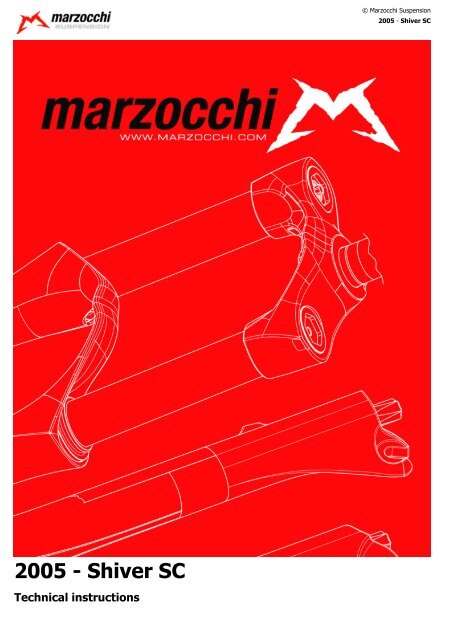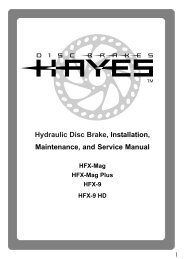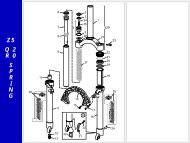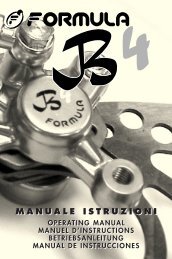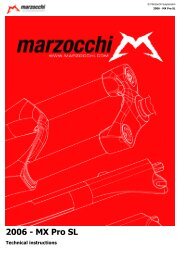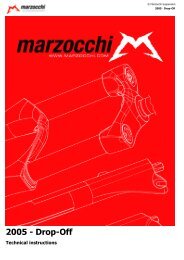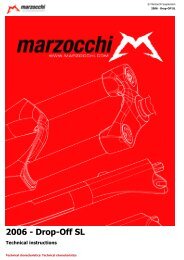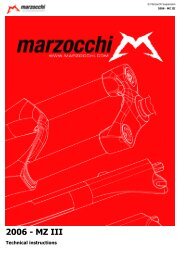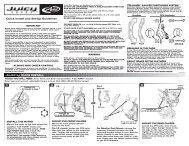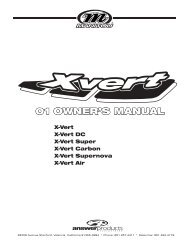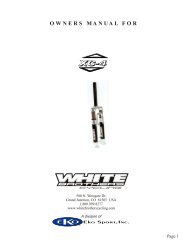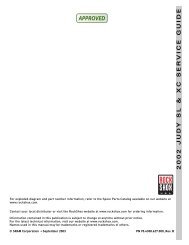You also want an ePaper? Increase the reach of your titles
YUMPU automatically turns print PDFs into web optimized ePapers that Google loves.
© Marzocchi Suspension<strong>2005</strong> - <strong>Shiver</strong> <strong>SC</strong><strong>2005</strong> - <strong>Shiver</strong> <strong>SC</strong>Technical instructions
© Marzocchi Suspension<strong>2005</strong> - <strong>Shiver</strong> <strong>SC</strong>Exploded view - <strong>Shiver</strong> <strong>SC</strong> 100Rif. Code Quantity1 532756>A 22 528050 23 819134/R 14 5321086 25 528223 26 523286>A 27 5181090>A 18 521142IW>A 29 532810>A 210 528214 211 703705KM/C 212 538110 213 522288 214 528172NOK>B 215 523261 216 533301 217 5181186>A 218 5141164/C 119 549062LA 220 523254BZ 221 520263BZ 222 701197/C 223 528218 224 532980 225 522342 226 547636 227 818142/AC 128 520264AC 129 520023PN 430 819133/R 131 520317PN 632 850724 133 900731>A 134 900730>A 138 818142/R 139 508996CD/C 140 538111 241 547632 144 547621 1<strong>Shiver</strong> <strong>SC</strong> 100 - Oil levelsPosition Oil type Quantity (cc)Right fork leg SAE 7,5 - 550013 135Left fork leg SAE 7,5 - 550013 135
© Marzocchi Suspension<strong>2005</strong> - <strong>Shiver</strong> <strong>SC</strong>Spare part list - <strong>Shiver</strong> <strong>SC</strong> 100Rif. Code DescriptionQ.ty in themodel1 532756>A FOOT NUT GROUP 22 528050 O-RING 23 819134/R R.H. DROP OUT+STANCHION TUBE 14 5321086 INNER SHAFT 25 528223 O-RING 26 523286>A STOP RING 27 5181090>A SPRIN GUIDE SLEEVE 18 521142IW>A NUT 29 532810>A ADJUSTER PIN 210 528214 O-RING 211 703705KM/C CART.100 MM TRAV.SHIV.<strong>SC</strong> 2004 212 538110 BUSHING 213 522288 UPPER WASHER 214 528172NOK>B OIL SEAL DIA.30 215 523261 STOP RING 216 533301 DUST SEAL DIA.30 217 5181186>A PRELOAD SLEEVE 30MM LONG 218 5141164/C SPRING KIT RED K=3,9 C.130 119 549062LA PRE LOAD KNOB- BLACK 220 523254BZ STOP RING 221 520263BZ ALLEN BOLT 222 701197/C PLUG 223 528218 O-RING 224 532980 EXTERNAL PRELOAD ADJUSTER 225 522342 WASHER 226 547636(replaces 547585)REBOUND ADJUSTER STICKER 05 227 818142/AC CROWN+OUTER TUBE+STEEL STEM 128 520264AC IN CAP AXLE 129 520023PN <strong>SC</strong>REW TCE M6X20 430 819133/R L.H.DROP OUT + STANCHION TUBE 131 520317PN <strong>SC</strong>REW 632 850724 AXLE KIT 133 900731>A LH PLASTIC SHIVER <strong>SC</strong> GUARD 134 900730>A RH PLASTIC SHIVER <strong>SC</strong> GUARD 138 818142/R CROWN+OUTER TUBES 139 508996CD/C REINFORCED STEEL STEM 1 1/8 140 538111 BUSHING 241 547632 RH+LH GUARD LABELS SHIVER <strong>SC</strong>05 144 547621 RH+LH LABELS SHIVER <strong>SC</strong> 05 1
© Marzocchi Suspension<strong>2005</strong> - <strong>Shiver</strong> <strong>SC</strong>Technical characteristics: Technical characteristicsSingle-crown fork with ø 30mm reverse legs.Available travels: 100 mm.Right fork leg damping element: spring with preload mechanical adjustment.Left fork leg damping element: spring with preload mechanical adjustment.Right fork leg damping system: H<strong>SC</strong>V cartridge with external rebound adjustment.Left fork leg damping system: H<strong>SC</strong>V cartridge with external rebound adjustment.The sliders are pressed into the crown.The guide of the stanchion tubes inside the sliders has special long-life bushes that are easy to reach.Lubrication and cooling of the parts subject to friction with a specially formulated oil.Steer tube: reinforced steel, 1-1/8", threadless.Crown: BAM® aluminium alloy forged and CNC machined.Top crown: aluminium alloy forged and CNC machined.Stanchions: anodised aluminium.Dropouts: aluminium alloy, CNC machined, fixed solidly to the stanchion tubes.Sliding bushings: made of friction-free and wear-free material.Springs: constant pitch.Seals: computer designed oil seals that guarantee maximum seal in any condition.Oil: specially formulated oil that prevents foam and keeps the viscosity unchanged while offering high performance; free from static friction.Dropout type: motorcycle type wheel axle support, with 20mm advanced axle and double screw locking system on both dropouts (specific wheelaxle, supplied).Disk brake mount: XC International Standard for 6" disk (fitting the special adapter supplied by the brake system manufacturer you can install the8" disk).Max wheel size: 2.8" x 26".Leg guards: available as option.BAM® : Bomber Aerospace Material: special alloy coming from the aerospace industry.
© Marzocchi Suspension<strong>2005</strong> - <strong>Shiver</strong> <strong>SC</strong>Warnings: Instructions for useMARZOCCHI forks are based on an advanced technology coming from the company’s years long experience in the professional mountain bikeindustry.For the best results, we recommend inspecting and cleaning the area below the dust seal and the stanchion tube after every use and lubricating theparts with some silicone oil.MARZOCCHI forks usually offer the best performances since the very first rides. Notwithstanding this, a short running-in period may be necessary(5-10 hours) to adjust the internal couplings. This precaution will lengthen your fork’s life and guarantee its best performances.We recommend changing the oil at least every 100 hours.The forks with a polished finish must be treated periodically with polishing paste to keep the exterior shining like new.Warnings: General safety rulesAfter disassembling the forks, always use new, original Marzocchi seals when reassembling.To tighten two bolts or nuts that are near each other, always follow the sequence 1-2-1, and tighten to the required tightening torque.Before reassembly, wash all new and old components and dry them with some compressed air, making sure there are neither breaks nor burrs.Never use flammable or corrosive solvents when cleaning the forks, as these could damage the fork’s seals. If you must use a solvent, usebiodegradable detergents that are not corrosive, non-flammable, or have a high flash point.Before reassembling, always lubricate those components that are in contact with the fork’s oil.If you are planning not to use your forks for a long period of time, always lubricate those components that are in contact with the fork’s oil.Always collect and keep any lubricants, solvents, or detergents, which are not completely biodegradable in the environment. These materials shouldbe kept in appropriate containers, and disposed of according to local laws.Always grease the seal lips before reassembling.All of the components of Marzocchi forks require the use of metric tools. Use only metric tools. Imperial (US) tools may have similar sizes, but candamage the bolts, making them impossible to loosen or tighten.When using a screwdriver to assemble or disassemble metal stop rings, O-rings, sliding bushings, or seal segments, avoid scratching or cutting thecomponents with the screwdriver tip.Do not carry out any maintenance and / or adjustment operations that are not explained in this manual.Only use original Marzocchi spare parts.Before servicing the fork, we recommend washing the fork thoroughly.Work in a clean, organized, and well-lit place. If possible, avoid servicing your forks outdoors.Carefully check to see that your work area is free of dust and metal shavings from any component of the forks.Never modify your fork in any way.Warnings: Fitting the fork onto the frameThe fork is supplied with “A-Head Set” steer tube to be cut to size according to frame being used.Fitting the fork onto the bike frame is a very delicate operation that must be carried out at one of our service centres only.The assembling on the frame and the adjustment of the steer tube must be carried out following the instructions of the steering set manufacturer.A wrong installation can be dangerous for the rider.Marzocchi does not guarantee the assembly and accepts no liability for damage and/or accidents arising from a wronginstallation.The steer tube must be pressed into the crown; its replacement must be carried out by one of our service centres using the adequate tools.A wrong installation of the steer tube into the crown may cause the rider to lose the control of the bike and lead to seriouspersonal injury.Warnings: Installing the disk brakeInstalling the brake system is a delicate and critical operation that must be carried out by an authorized Marzocchi Service Center.Marzocchi is not responsible for the installation and accepts no liability for damage and/or accidents arising from this operation.Improper installation of a disk brake system can overstress the caliper mountings, which may cause the caliper mountings to break, resulting in lossof control of the bicycle, an accident, personal injury, or death. Be sure that the brake system installation is also performed in strict compliance withthe instructions provided by the brake system manufacturer.Improper installation can result in an accident, personal injury, or death.Use only brake systems that comply with the forks specifications.The brake cable must never touch the crown and stanchions.Warnings: Assembling the wheelFor a correct operation of the fork, install the wheel as explained below:Insert the wheel axle (1) through the right dropout, the wheel and the left dropout.With the 6mm Allen wrench, tighten the left screw (2) to the recommended tightening torque (15 Nm ±1).Check the correct fork-wheel alignment by fully compressing the fork a few times. The wheel should notcome into contact with any parts of the fork.Lift the front wheel above the ground; turn the wheel a few times to verify the correct alignment with thedisk brake. Read the instructions of the brake system manufacturer for the correct specifications.
© Marzocchi Suspension<strong>2005</strong> - <strong>Shiver</strong> <strong>SC</strong>With a 5mm Allen wrench, tighten the screws (3) on both dropouts to the recommended tighteningtorque (10 Nm ± 1) following the sequence 1-2-1.
© Marzocchi Suspension<strong>2005</strong> - <strong>Shiver</strong> <strong>SC</strong>Dismantling: Removing the top capsPut the fork in the vice in vertical position, fixing it by the dropouts.With a 1.5mm Allen wrench loosen the grubscrew (4) and remove the adjusting knob (5).Remove the stop ring (8).With a 21mm socket spanner fully unscrew lock cap (1).Remove the lock cap (1).Remove pusher (7) from the threaded pin (6) of the pumping element taking into account that these twoparts have a left-hand threading.Dismantling: Draining the oilRemove washer (1), the preload tube (2) and spring (3) from both legs.
© Marzocchi Suspension<strong>2005</strong> - <strong>Shiver</strong> <strong>SC</strong>Free the fork from the vice and tip it into a container of a suitable size to drain the oil; compress the forka few times to help the oil flow out.Do not pour used oils on the ground.Dismantling: Dismantling the hydraulic cartridgeProceed as follows for both legs:Turn the fork leg upside down and loosen the bottom nuts (8) with a 15mm socket spanner.Pull out bottom nuts (8) complete with O-rings (9).Pull the complete cartridges (5) off the fork legs.Holding locknut (1) with a 10mm fixed spanner, loosen the threaded pin (2) using a 7.5mm fixedspanner.
© Marzocchi Suspension<strong>2005</strong> - <strong>Shiver</strong> <strong>SC</strong>Remove the threaded pin (2) and locknut (1).Remove the spring guide tube (7).The H<strong>SC</strong>V cartridges (5) are sealed through machining and cannot be overhauled. In the caseof faults or a malfunctioning, they must be replaced.Dismantling: Breaking down stanchion tube, slider and removing the sealing ringsThis operation must be done only after having drained all of the oil out of the slider.Prize the dust seal (1) off its seat with a small flat-tip screwdriver.Take great care not to damage the internal surfaces of the slider while removing the dustseal.
© Marzocchi Suspension<strong>2005</strong> - <strong>Shiver</strong> <strong>SC</strong>With the same screwdriver, prize off the metal stop ring (2).Take great care not to damage the internal surfaces of the slider while removing the stopring.Pull stanchion (3) out of slider (4); to separate these two elements you will have to pull hard. With thisoperation the sealing ring (5), the spring cup (6) and the bottom guide bush (7) will be removed from theslider.Remove the top guide bush (8) by hand. If this operation is difficult by hand, use a flat-tip screwdriver inthe bush groove.Remove the bottom guide bush (7), the spring cup (6), the sealing ring (5), the stop ring (2) and thedust seal (1) from the stanchion.The old sealing rings and the dust seals must not be used again.Remove the top guide bush (8) by hand. If this operation is difficult by hand, use a flat-tip screwdriver inthe bush groove.Remove the bottom guide bush (7), the spring cup (6), the sealing ring (5), the stop ring (2) and thedust seal (1) from the stanchion.The old sealing rings and dust seals must not be used again.
© Marzocchi Suspension<strong>2005</strong> - <strong>Shiver</strong> <strong>SC</strong>Assembling: Reassembling stanchion tube, slider and sealing ringsThe old sealing rings and dust seals must not be used again.Before reassembling, check the conditions of the guide bushes. Replace, if they are scratched or grooved. Check the wearproofcoating of the guide bushes which must be in a good condition.Apply some adhesive tape to the end of the stanchion so that it covers the seat of the top bush.Smear the dust seal and the sealing ring with some grease.Insert the following components in the stanchion tube in this order: dust seal (1), stop ring (2), sealingring (5), spring cup (6) and bottom guide bush (7).Remove the adhesive tape from the end of the stanchion tube, cleaning any traces of adhesive left on thefork.Insert the top guide bush (8) by hand.If this operation is difficult by hand, use a flat-tip screwdriver in the bush groove.Gently introduce the stanchion into the slider, being very careful not to damage the top guide bush.Guide the bottom guide bush until it comes in contact with the slider, the spring cup and the sealing ring.Mount introducer (A) on the stanchion and use this, by pushing on sealing ring (5), to insert the bottomguide bush, the spring cup and the sealing ring.Mount stop ring (2) using a small flat-tip screwdriver checking that it fits perfectly into its groove andbeing very careful not to scratch the stanchion tube.
© Marzocchi Suspension<strong>2005</strong> - <strong>Shiver</strong> <strong>SC</strong>Re-assemble the dust seal (1) in its seat, pressing it home with your hands.Assembling:During the assembly of the pumping unit, strictly obey the instructions below.Do not, at any times, reverse the position of the pumping elements in the fork legs (if you are unsure about anything, please referto the relevant exploded view).Assembling: Assembling the cartridgeProceed as follows for both legs:Insert the spring guide tube (7) in the cartridge rod.Tighten locknut (1) on the cartridge rod.
© Marzocchi Suspension<strong>2005</strong> - <strong>Shiver</strong> <strong>SC</strong>Tighten the threaded pin (2) on the cartridge rod being careful not to damage the O-ring.With the 10mm and 7.5mm spanners, tighten locknut (1) on the threaded pin (2) to the recommendedtightening torque (6 Nm ± 1).Insert the complete cartridge (5).Using a 15mm socket spanner, tighten the bottom nuts (8) with O-rings (9) to the recommendedtightening torque (10 Nm ± 1).Assembling: Filling with oilBlock the fork in the vice, in perfectly vertical position.Fully lower the sliders and the cartridges on the stanchion tubes.
© Marzocchi Suspension<strong>2005</strong> - <strong>Shiver</strong> <strong>SC</strong>In a graduated recipient, prepare the quantity of oil to pour into the fork leg (see table).Pour roughly 1/3 of the oil required into each stanchion, then pump the fork a few times to eliminate anytraces of air.Pour the rest of oil in.A lower or higher volume or a type of oil other than the one recommended can change the behaviour of the fork in every phase.Lift the sliders with cartridges off the stanchion tubes.Insert spring (3), the preload tube (2) and washer (1) in both legs.Assembling: Mounting the top capsPut the fork in the vice in vertical position, fixing it by the dropouts.Tighten pusher (7) on the threaded pin (6). In this way, the stop ring groove on the same pin will bevisible once the cap has been assembled.The pusher and the threaded pin have a left-hand threading; therefore they shall be screwed downturning the pusher counter-clockwise.
© Marzocchi Suspension<strong>2005</strong> - <strong>Shiver</strong> <strong>SC</strong>Fit lock cap (1) and, with a 21mm socket spanner, tighten to the recommended tightening torque (10 Nm± 1).Mount the stop ring (8).Mount the adjusting knob (5) and, with a 1.5mm Allen wrench, tighten the grubscrew (4) to therecommended tightening torque (1.5 Nm ± 2).
© Marzocchi Suspension<strong>2005</strong> - <strong>Shiver</strong> <strong>SC</strong>Setting: General rules for calibrationBy carefully calibrating the damping system you can get the maximum performance out of the same.This paragraph indicates the sequence of operations to perform to set up the Marzocchi forks correctly.In order to find the best settings for you, you will need to try several times to understand where and how to make adjustments. When doing so,please ride in an open area, free from traffic, obstacles and other hazards.The optimal setting is influenced by the geometry of the frame of the mountain bike, the weight of the cyclist, the type of terrain the bike will beused on and the type of obstacles you have to deal with, but also by subjective factors associated with your riding style; therefore it is impossible toprovide objective data on the desired settings.Nevertheless by carefully following the instructions below you will soon be able to find the optimal setting for you.The shock absorber must be calibrated simply by using one adjuster at a time, following the order explained, noting the operations and any resultstep-by-step.During setting don't force the adjusters beyond their limit of travel and don't exceed the max recommended air pressure.To keep the pressure inside the fork’s legs, only use the special MARZOCCHI pump with pressure gauge.The use of any other pump can compromise the inflating operation and cause malfunction or damage to the fork, resulting in anaccident, personal injury or death.Once the correct setting has been found, we recommend noting the number of clicks or turns of the adjuster with respect to the "fully closed"position (adjuster fully clockwise) for a faster re-setting of your fork in case of need.Setting: SAGSAG means the fork bottoming under the biker's weight.How to measure the SAG:Follow these simple steps to measure the SAG.On the leg portion of the fork, measure the distance between the lower crown and the dust seal (seePicture A). Note this value as “H1”.While sitting on the bike, repeat the measurement (see picture B). Note this value as “H2".SAG = H1 - H2How to find the best percent SAG:The best percent SAG is 15-20% for Cross-country and All Mountain forks and 25-30% for Freeride andDownhill forks.In order to calculate the best SAG for your own fork, you will need to make the following calculation:SAG = T x S (T = total travel; S = suggested sinking percentage).Setting: Spring preloadFor both fork legs:The optimal spring preloading is the one that lets you obtain the desired SAG under the biker's weight.The forks are factory-set to the minimum preload, say with the adjuster fully turned counter-clockwise.In this configuration, the spring is slightly preloaded to counteract static loads.Turning adjuster (A) clockwise increases the spring preload.Turning adjuster (A) counter-clockwise decreases the spring preload.
© Marzocchi Suspension<strong>2005</strong> - <strong>Shiver</strong> <strong>SC</strong>Do not force the adjuster beyond its limit of travel.Setting: Rebound adjustmentRight fork leg:With the rebound adjuster you can control the return speed of the fork after compression.The right rebound speed setting makes the bike stable letting it follow the variations in the terrain and any obstacles.If the fork setting is too reactive this will make the rear suspension instable and the mountain bike will have a tendency to snake. A too slow settinghowever will cause problems when dealing with multiple obstacles where the suspension can't return to its fully extended position fast enoughbetween one obstacle and the next.Turning adjuster (A) clockwise increases the hydraulic damping making the fork slower during therebound phase.Turning adjuster (A) counter-clockwise decreases the hydraulic damping making the fork more reactiveduring the rebound phase.Do not force the adjuster beyond its limit of travel.
© Marzocchi Suspension<strong>2005</strong> - <strong>Shiver</strong> <strong>SC</strong>Tightening torquesComponentsTightening torque (Nm)Fork leg top caps 10±1Preload knob locking grubscrews 1,5±0,2Preload knob locknut 6±1Pumping element/cartridge bottom nuts 10±1Wheel axle Allen screws 10±1Wheel axle screws 15±1<strong>Shiver</strong> <strong>SC</strong> 100 - Oil levelsPosition Oil type Quantity (cc)Right fork leg SAE 7,5 - 550013 135Left fork leg SAE 7,5 - 550013 135
© Marzocchi Suspension<strong>2005</strong> - <strong>Shiver</strong> <strong>SC</strong>DiagnosticsFinding the problem Finding the possible cause Possible solutions proposedFork doesn't get full travel Oil level too high Check oil levelsFork doesn't get full travel Spring rate too stiff Change to softer spring rateFork doesn't get full travel Spring rate too stiff Decrease air pressureFork extends too quickly; harsh top-out afterimpactsFork extends too quickly; harsh top-out afterimpactsRebound damping is not enoughRebound damping is not enoughIncrease rebound dampingFork has too much sag Oil is too fluid Check oil levelsReplace the oil (SAE 7.5) with one of higherviscosity indexFork has too much sag Spring rate too soft Change to stiffer spring rateFork has too much sag Spring rate too soft Increase air pressureFork has too much sagFork is “sticky”; fork does not perform as newFork is too soft, but the sag is the onerecommendedFork is too soft, needs more than the maximumpreloadFork is too soft, needs more than the maximumpreloadFork is too soft, needs more than the maximumpreloadFork stays down or "packs up" during multipleimpactsFront wheel tends to tuck under while turning leftor rightFront wheel tends to tuck under while turning leftor rightHeavy amount of oil on stanchions; oil drippingdown legsHeavy amount of oil on stanchions; oil drippingdown legsKnocking sound during rebound, but no harsh topoutSpring rate too softDirty sealing rings; fork needs to beservicedCompression damping is not enoughOil is too fluidSpring rate too softSpring rate too softRebound damping is too highRebound damping is too highSpring rate too softSealing rings damagedThe stanchion tubes could be damagedRebound damping is too highIncrease spring preload by replacing the preloadtubeRenew all sealsIncrease compression damping by changing oilvolumesCheck oil levelsChange to stiffer spring rateIncrease air pressureDecrease rebound damping with the relevantregisterDecrease rebound damping with the relevantregisterChange to stiffer spring rateRenew all sealsLoss of sensitivity Old oil Change the oilHave the stanchions be checkedDecrease rebound damping with the relevantregisterLoss of sensitivity Sliding bushes worn Renew the sliding bushesOil leaking from the bottom of the fork leg Bottom nut/screw loose Tighten the nut or screwOil ring on stanchions Sealing rings dirty Renew all seals


